 |
 |
 |
 |
 |
Any normal magic square may be transformed into another magic square by subtracting
each number in turn from n2 + 1. This process is referred to as
complementing the magic square.
It is also referred to as 'complementary pair interchange' (CPI for short) because in
effect you are interchanging the two numbers that together sum to n2 +
1 ((R. S. Sery).
Under certain conditions the resulting magic square will be a reflected copy of the
original magic square.
To illustrate using the Lo-shu magic square
|
each number subtracted from 10 transforms to |
|
A horizontal and a vertical reflection will make the transformed square identical to the original. |
This type of magic square was introduced on Mutsumi Suzuki’s Magic Squares page
when he originally showed 6 order-5 magic squares of this type. He coined the name Self-similar
magic squares.
Recently I revisited this page and discovered he had greatly expanded it, including 352
order-4 magic squares of this type.
Visit his large, comprehensive magic squares site from my links page.
On studying his page, I realized that the first group (his group A) of 48 order-4 magic
squares are the only 48 associated magic squares of order-4.
On examining his order-5 self-similar magic squares, I find that they also are associated
magic squares.
When I checked associated magic squares of other orders I found that in each case they
were self similar.
Order-4 Associated Used to demonstrate why associated magic squares are all self similar
Order-4 not associated A class of 304 magic squares that are self-similar but not associated.
Order-4 not self-similar An example showing why most magic squares are not self-similar.
Order-5 Associated A sample lozenge associated magic square and its complement.
Order-6 not associated An example that is horizontally self-similar.
Order-7 associated A sample associated magic square and its complement.
Order-8 associated A sample pandiagonal associated magic square and its complement.
Order-8 not associated a bordered order-8 that is horizontally symmetrical and thus self-similar.
Order-9 associated A sample lozenge associated magic square and its complement.
Higher dimensions An order-3 magic cube and an order-3 magic tesseract.
Summery Conclusions and questions.
![]()
|
This magic square is associated and semi-pandiagonal.
|
||||||||||||||||
|
This is the complementary copy of the above magic square. It is obtained
by subtracting each number of the above square from 17. It is reflected horizontally and
vertically from the original |
||||||||||||||||
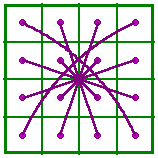 |
This pattern is constructed by joining integer pairs that sum to n2 + 1. The self-similar (complementary) magic square is constructed by simply exchanging the two numbers of each pair. Because it is completely symmetrical, the complementary square is self-similar and is reflected horizontally and vertically from the original. |
Higher orders of associated magic squares have similar patterns, only with more lines. Note that every line passes through the center of the square. For this reason associated magic squares are also called symmetrical magic squares.
The previous section mentioned that all associated magic squares, regardless of the order, have the self-similar property.
However, there is another type of order-4, and almost surely, other orders, that also
have this property.
They are Dudeney’s type VI of which 96 are semi-pandiagonal and 208 are simple magic
squares.
This is Frénicle’s index #1 , it’s complement and it's Dudeney pattern. It is a simple magic square.
|
|
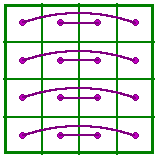 |
||||||||||||||||||||||||||||||||
| Note that this complementary square needs only a horizontal reflection to make it identical to the original | ||||||||||||||||||||||||||||||||||
|
|
 |
||||||||||||||||||||||||||||||||
| This one is Frénicle # 182, it's complement and Dudeney
pattern. It is semi-pandiagonal. This time the complementary square needs a vertical reflection to make it identical to the original. Comparing the complement pair patterns for the two squares makes it obvious why this is so. If magic squares of higher orders have complementary pair patterns equivalent to these, then those magic squares will also be self-similar. Whether these magic squares are semi-pandiagonal or simple seems to have no bearing on whether a horizontal or vertical reflection is required to match the complement to the original. The complements of both magic squares below require a horizontal reflection to match the original even though the squares are of different types. |
||||||||||||||||||||||||||||||||||
Frénicle #53 simple
|
Frénicle #54 semi-pandiagonal
|
|||||||||||||||||||||||||||||||||
Credits regarding order-4
Mutsumi Suzuki lists 352 self-complementary magic
squares of order-4.
His group A shows 48 magic squares that when complemented require a horizontal and a
vertical reflection to match the original. These are the 48 Dudeney Type III associated
semi-pandiagonal magic squares.
His group B lists 304 magic squares that when complemented require only a horizontal or
a vertical reflection to match the original. These are the 96 Dudeney Type VI
semi-pandiagonal magic squares and the 208 Dudeney Type VI simple magic squares.
Visit Mutsumi Suzuki’s large, comprehensive magic squares page from my links page.
Bernard Frénicle de Bessy published the 880 basic solutions for the order-4 magic squares in an indexed order in Des Quarrez Magiques. Acad. R. des Sciences 1693.
H. E. Dudeney published a classification of these 880 magic squares with the enumeration of each type in Amusements in Mathematics, Dover Publ., 1970, 0-486-20473-1. This is a reprint of a book first published in 1917.
|
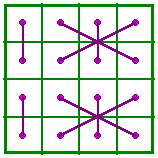 |
This is Frénicle #181. Dudeney group XI. A look at the Dudeney pattern
for this magic square confirms that the complementary pairs are not symmetrical across
either the horizontal or the vertical center lines. This is the condition required for a
magic square to be self-similar. |
|
|
Because this is an associated magic square, the complementary square must
be both horizontally and vertically reflected to match the original. This particular square is also a lozenge magic square. Notice how the odd numbers are grouped.
|
![]()
|
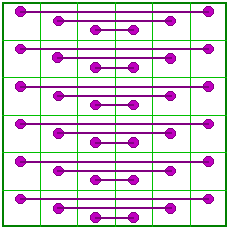 |
This order-6 magic square is not associated but is symmetric across the vertical center line so produces a self-similar copy of itself. There are no associated pure magic squares of order 6. |
Because this is an associated magic square, the complementary square must be both horizontally and vertically reflected to match the original.
|
|
This square is pandiagonal as well as being associated.
|
|
![]()
This magic square is not associated but symmetric across the vertical center, so
produces a horizontally reflected version of itself.
It is also a bordered magic square. A double row of cells surrounds a 4 x 4 center magic
square. Complementing only the center magic square or only the border cells will produce 2
variations. Rotating the center 4 x 4 either 90 or 270 degrees produces other variations.
|
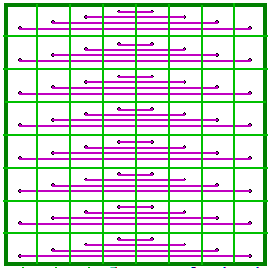 |
![]()
|
 |
|||||||||||||||||||||||||||||||||||||||||||||||||||||||||||||||||||||||||||||||||
|
This associated magic square is also composite. It consists of nine
order-3 associated magic squares themselves arranged as an order-3 magic square. If each
number in this order-9 square is exchanged with it's complement as per the Dudeney
pattern, the result is the same magic square rotated 180 degrees. In addition, each of the nine order-3 magic squares can be converted to its complement (itself but rotated 180 degrees) by subtracting each number from the sum of the first and last number in that magic square. This in turn will produce another order-9 associated magic square (shown at left) which is also self-similar. Any order-3 or combinations of order-3 may be rotated to get variations in the order-9 magic square. Notice that for simplicity, some lines in the pattern (above) are covered up by others. The center horizontal line, for example, actually consists of four pairs. |
![]()
The self-similar feature also works for associated magic cubes and tesseracts. I assume
it works for the higher dimensions as well.
Shown here is an order-3 cube and an order-3 tesseract, both are complements of those
shown on my John Hendricks page. Refer to
that page for more information on these figures.
Just as the 1 order-3 magic square is associated, so also are the 4 basic magic cubes and
the 58 basic magic tesseracts.
|
|
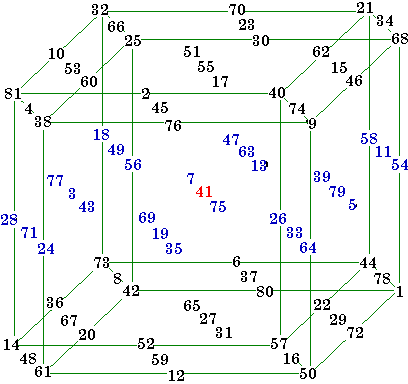 |
The magic cube has 13 complementary pairs with the two members on opposite sides of the central number 14. This self-similar figure is one of the 47 equivalents to the cube on Hendricks page.
The magic tesseract shown above has 40 complementary pairs around the central number 41. Two such pairs are 32, 50 and 18,64. This self-similar figure is one of the 383 equivalents to the tesseract on Hendricks page.
![]()
All associated magic squares (and higher dimensions) have the self-similar property.
i.e. if each number in the square is subtracted from the sum of the first and last number
in the series, the resulting magic square is a duplicate of the original but rotated 180
degrees.
This process of complementing all numbers may be referred to as complementary
pair interchange (CPI).
Any non-associated magic squares that have complementary pairs that are symmetric
across either the horizontal or the vertical center line produce self-similar copies that
are either horizontally or vertically reflections of themselves.
I have shown such a pattern (above) for orders 4 and 6.
All order-4 associated magic squares are semi-pandiagonal. Are ALL associated magic squares semi-pandiagonal?
![]()
 Please send me Feedback
about my Web site!
Please send me Feedback
about my Web site!![]()

![]()
![]()
Harvey Heinz harveyheinz@shaw.ca
This page last updated
February 28, 2009
Copyright © May, 2000 by Harvey D. Heinz